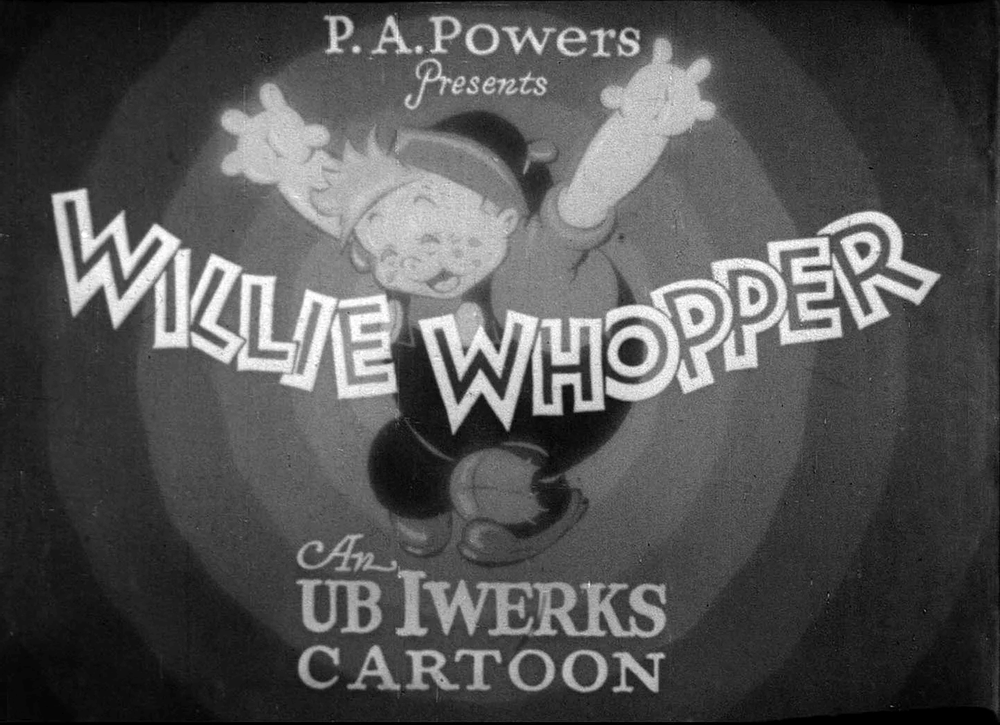
Willie Whopper was a short lived series of cartoons produced and directed by Ub Iwerks, running for 13 shorts from 1933 to 1934. The series was made as a replacement for Iwerks' previous series Flip the Frog, alongside his Comi Color Cartoons shorts.
The shorts all follow a simple formula—Willie, a young, eager boy, tells his friends (or sometimes, the audience) about some outlandish adventure he went on recently, which serves as the story in question for the short—naturally, the stories turn out to be nothing but exaggerated lies (or, "whoppers", hence his name). Like other Iwerks cartoons, the shorts are rife with cartoony animation, as well as a stylized rubberhose art style, courtesy of designers such as Grim Natwick and Berny Wolf. Carl Stalling would also provide pleasant, if pedestrian scores for the shorts. The series was usually produced in black and white, although there were three entries which were filmed in color, and Iwerks still had his cels colored in spite of the black & white footage, to see if he could get different shades of gray in the photographing.
While the series was fairly well received when it was released, it came to an abrupt end when MGM dropped distribution of Ub's cartoons, instead choosing to distribute Harman and Ising's Happy Harmonies shorts. As such, Ub abandoned the character and shifted focus towards his ill-fated Comi Color Cartoons, with Willie becoming yet another one of many forgotten stars of the Golden Age of Animation.
Fortunately, some of his cartoons have fallen into the Public Domain, and as such are easy to find, giving his films a chance to see the light of day again. In late 2015, Thunderbean animation released a restored Blu-ray & DVD set of all of his cartoons.
Filmography
1933
- The Air Race: The pilot for the series, but the original version was unreleased due to MGM demanding more exposition as to why Willie joined the air race.
- Play Ball
- Spite Flight: Semi-remake of "The Air Race". While it reuses footage from the original film, there are considerable differences in the plot and a lot of new footage has been added.
- Stratos-Fear: The first film in the series to use Willie's fat redesign.
- Davy Jones Locker: Filmed in color.
1934
- Hell's Fire (AKA Masquerade Holiday and Vulcan Entertains): Originally, a complete color print of the film was thought to be lost, but one was found and restored for the 2015 Willie Whopper blu-ray set.
- Robin Hood, Jr.
- Insultin' the Sultan
- Reducing Creme
- Rasslin' Round
- Cave Man
- Jungle Jitters
- The Good Scout
- Viva Willie
Tropes:
- All Just a Dream: The ending of "Stratos-Fear", where Willie awakens from his laughing gas induced nightmare by having his tooth yanked out.
- Art Evolution: Willie initially looked like a boy version of Betty Boop, but Ub didn't feel he was funny enough, and quickly altered his design to be fatter and lankier than before.
- Bandito: "Viva Willie" features Willie taking on Pancho Villa.
- Batman Can Breathe in Space: Willie demonstrates this in "Stratos-Fear" when he gets inflated with laughing gas and floats off into space.
- Behind a Stick: The fat-cat villain of "The Air Race"/"Spite Fight" eavesdrops while leaning out from behind a very narrow tree that somehow conceals the rest of him.
- Catchphrase: The quote that introduces this page popped up in many of the shorts.
- Drinking on Duty: In "Viva Willie", Willie's horse drinks almost all of an unattended barrel of beer while Willie is visiting the cantina. As a result, he is staggeringly drunk by the time Willie needs him to chase after Pancho.
- Easter Egg: In "Air Race", one of the shops Willie crashes into has the name Iwerks.
- Falling Chandelier of Doom: In "Viva Willie", Willie corrals Pancho and his gang by dropping a wagon wheel chandelier on them: trapping them between the spokes of the wheel.
- Fire and Brimstone Hell: Which is convieniently located under a volcano in "Hell's Fire".
- Flipping the Bird: In a decidedly anti-clerical joke, "The Air Race" gives us an angry St. Peter, who is waiting on the cloud trying to hitch a ride with a plane rider, gets passed up, and angrily flips the bird at him—with four fingered hands.
- Fluffy Cloud Heaven: In "The Air Race", we get a glimpse of St. Peter at the gates of Heaven, trying to hitch a ride with the plane racers.
- Four-Fingered Hands: And they can still flip the bird with them, going by St. Peter's brief appearance.
- Inflating Body Gag: In "Stratos-Fear", Willie gets filled with too much gas at the dentist, causing him to inflate and fly off into space.
- iSophagus: In "Viva Willie", Willie accidentally swallows his harmonica while riding his horse. For the rest of the cartoon, he speaks only in a string of strangled harmonica notes. At the end, his girlfriend gives him a passionate kiss and ends up with the harmonica stuck in her throat.
- Meaningful Name: Whopper was a classic phrase for a lie.
- No Celebrities Were Harmed: Amelia Earhart makes an appearance in "The Air Race".
- Roger Rabbit Effect: Theclimax of "The Air Race" has a brief segment of Willie's plane crashing into a real life smokestack. In fact, a scene similar to this was originally meant to be done in the original Mickey Mouse cartoon Plane Crazy, but was scrapped.
- "Spite Flight" also ends with a new live action/animation mixing ending, with Willie and co. riding in a parade.
- Satan: A cartoony version of him appears in "Hell's Fire".
